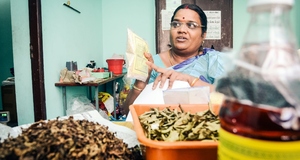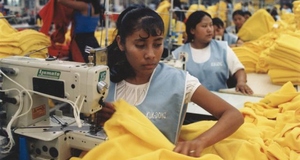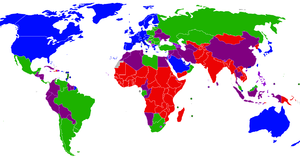Rethinking Microcredit in Bangladesh: Does Grameen Bank Serve the Neoliberal Agenda?
By
2016, Vol. 8 No. 09 | pg. 1/2 | »
IN THIS ARTICLE
KEYWORDS
Grameen Bank, translated as "rural bank" in the Bangla language, is a grassroots microcredit organization founded in 1983 by Bangladeshi economist Muhammad Yunus to provide new financial opportunities to the poor. Grameen Bank and Muhammad Yunus were jointly awarded the Nobel Peace Prize in 2006 for their development efforts through microcredit. As of October 2011, Grameen Bank has over 8 million borrowers, 97% of whom are women (Grameen Bank, n.d.). The Bank provides services to more than 97% of villages in Bangladesh with 2,565 branches across the country and is especially well known around the world for its surprising loan recovery rate of over 98% (Grameen Bank, n.d.). In the 1990s, Grameen Bank’s microcredit approach gained widespread international interest and was incorporated into mainstream development agendas around the world. Microcredit is a program designed to provide very small loans to the poor to create small business enterprises without requiring any financial collateral. The shift towards microcredit was a result of globalization, trade liberalization, and the negative effects of Structural Adjustment Programs. However, the emergence of microcredit in mainstream Western-directed development efforts also resides within a political context that was essential in securing its popularity in the West. Muhammad Yunus, Grameen Bank, and the concept of microcredit received much Western press attention and came to be supported by political personalities in North America, including Bill and Hillary Clinton (Rahman, 1999, p. 13). Western backing for Grameen Bank and microcredit led to almost all international development organizations incorporating microcredit as key components in their programs around the world. Grameen Bank is promoting a Western neoliberal agenda and advancing corporate capitalist interests through its microcredit operations in Bangladesh.
This paper asks some important, critical questions of microcredit's fast rise. How succesful was microcredit in delivering real results and practical solutions to rural Bangladeshis? How are NGOs, neoliberalism and microcredit connected and what is Grameen Bank’s model of development? What role does Grameen Bank play in empowering rural Bangladeshi women? Why does Grameen Bank promote social businesses and in what ways are they linked to microcredit? In this paper, I address these questions. I argue that in the name of development, Grameen Bank is ultimately promoting a Western neoliberal agenda and advancing corporate capitalist interests through its microcredit operations in Bangladesh.
Neoliberalism and NGOs in BangladeshNeoliberalism as a political-economic paradigm first emerged in the 1970s and gained acceptability in the 1980s with the aggressive support of Ronald Regan and Margaret Thatcher (Muhammad, 2015). The fall of the USSR further supported the domination of neoliberal ideology in development thinking, which called for deregulation, privatization and the withdrawal of the state as well as encouraged and backed private enterprises and entrepreneurial initiatives for the creation of wealth (Muhammad, 2015; Harvey, 2007, pp. 3, 64). In a neoliberal state, individual responsibility and accountability are key to an individual’s well-being (Harvey, 2007, p. 65). Public expenditures for education, healthcare, safe drinking water, etc. are considered liabilities and as the military budget, corporate subsidies and tax facilities for the rich are prioritized, austerity is used as a weapon against the public (Muhammad, 2015). However, even guided by neoliberalism, economic performance and growth rates are still far below what they previously were in the fifties and sixties during the time of state-directed, welfare state oriented capitalism (Graeber, 2013, p. 5). Bangladesh formally entered the global economy in 1971 as an independent state. Although Western development aid brought in foreign money and consumer products to Bangladesh, it ultimately affected local development from the 1980s as large-scale community development projects were carried out by privately owned organizations instead of the government (Faraizi, Rahman & McAllister, 2011, p. 113). This was a direct consequence of Structural Adjustment Programs forcefully imposed on developing countries, including Bangladesh, by the International Monetary Fund and World Bank as conditions for taking out their loans under the Washington Consensus (Faraizi, Rahman & McAllister, 2011, p. 113; Muhammad, 2015). Structural Adjustment Programs led to drastic reductions in the social sector and in social safety nets, increased unemployment and were intended to privatize nationalized industries, open up markets for foreign investments and devalue currencies (Fernando, 1997, p. 157; Isserles, 2003, p. 41). The costs of structural adjustments disproportionately affected the poor and international development agencies looked for new approaches to poverty alleviation that came in the form of political economic regimes supporting liberal economic reforms (Fernando, 1997, pp. 157-158). This is when microcredit gained widespread acceptance within international development agencies as it advanced “the liberal ideology of private entrepreneurial capitalism and social mobilization” (Fernando, 1997, p. 158). Diminished government responsibility and the privatization of welfare were vital in implementing neoliberalism around the world, including Bangladesh. Bangladesh was forced by international aid organizations, foreign governments and development funding banks to divert funding and welfare responsibilities to the private sector, where private individuals were mainly interested in acquiring money, power and prestige at the expense of the welfare of the poor (Faraizi, Rahman & McAllister, 2011, p. 113). Western governments replaced the Bangladeshi state through the funding of the NGO sector. Karim (2011) suggests that NGOs now essentially act as a shadow state in Bangladesh (p. 200). The Bangladeshi state is held hostage by powerful politicians who misuse the state apparatus for their own benefits and corrupt bureaucrats, owners of multinational corporations and politicians, whether they are in power or not, all cooperate to further weaken the state (Faraizi, Rahman & McAllister, 2011, p. 114). As the Bangladeshi state is weak and largely ineffective, it is prone to exploitation by both local and international NGOs. Powerful NGOs, with huge amounts of resources and global connections and clients, are easily able to establish the fact that government organizations in Bangladesh are corrupt and ineffective in providing welfare services to the poor and are able to manufacture knowledge about the needs of the poor (Karim, 2011, p. 201; Faraizi, Rahman & McAllister, 2011, p. 114). In the name of improving the lives of the poor, NGOs thus legitimize their development interventions in “underdeveloped countries,” such as Bangladesh, to Western audiences. In order to secure an unchallenged position in Bangladeshi society as well as development-dominated spaces, NGOs implement various strategies to silence any opposition. Their strategies include hiring numerous university professors and researchers as consultants in programs that they operate, creating a trend where many university professors are full-time NGO consultants and part-time academics (Karim, 2008, p. 13). Due to the absence of the state and state sponsored services in rural areas, NGOs in Bangladesh are able to play a huge hegemonic role over the lives of the poor through their services. NGOs provide two-thirds of institutional credit in rural Bangladesh (Karim, 2008, p. 12). They are also a huge source of employment in a country such as Bangladesh with limited employment opportunities. NGO executives take part in all major development initiatives in Bangladesh alongside donors and government officials and are thus able to participate in the nation-building decisions of Bangladesh (Karim, 2011, p. 201). As Bangladesh is a postcolonial nation dependent on Western aid, NGOs strategically use this weakness to carry out their development interventions in the country. Grameen Bank, Microcredit and DevelopmentDevelopment as trusteeship is considered by many to have no meaning for “Third World” countries today (Cowen & Shenton, 1995, p. 27). However, I disagree as the colonial notion of trusteeship or taking on the “White Man’s Burden,” which once gave Europeans the power to manage the development of populations in the Global South, seems to have taken on a new form with the development interventions of NGOs in countries such as Bangladesh. While the West points to development as “the betterment of human kind through the alleviation of poverty and the realization of human potential,” it is important to realize that there are both good and bad forms of development (Cowen & Shenton, 1995, p. 25). Nanda Shrestha (1995) points out that development ideology is propaganda that is produced to conquer the minds of native elites in the Global South and establishes a culture of materialism, where poverty and the poor are social creations to subordinate and marginalize the people of the Global South (p. 259). I would go even further and say that development ideology has entirely colonized the mindsets of non-Western people in the Global South, both rural and urban, and has transformed them into consumers of Western-led development. Microcredit is viewed as a way for the poor to achieve self-reliance and independence in order to eradicate poverty. However, this conception of poverty is treated as a temporary state that can be solved by improving cash flow, which assumes that the poor in the Global South are able to become “developed” people with just a little bit of credit (Isserles, 2003, p. 44). Robin Isserless (2003) makes a very important point, “Turning people into indebted entrepreneurs and self employed workers may only serve to intensify Western ideological assumptions that the developing world should mirror the First World. The consequence is an overly narrow conception of what it means to be a "developed" society and what constitutes "progress"” (p. 55). Today’s development policies give the illusion that everyone around the world is given an equal opportunity to take part in the decisions affecting their lives, that nobody is discriminated against and that opportunities exist for everyone to become successful (Cornwall & Brock, 2005, p. 1044). However, these assumptions are far from the realities of people living in the Global South whose opportunities are very limited and their agency often taken away by NGOs, the self-declared guardians of the poor, exercising moral authority over them. NGOs make life-changing decisions, most of which have adverse effects, for non-Western people who they perceive as “backward” and “poor.” As non-Western people living in the Global South are not consulted by NGOs on decisions that concern them, they are therefore deprived of their agency and autonomy to make their own decisions. Buzzwords in mainstream development discourse, such as participation, empowerment and poverty reduction are used by the most influential development agencies to justify and provide legitimacy to their development interventions (Cornwall & Brock, 2005, p. 1047). Poverty reduction specifically indicates economic growth attained through privatization and liberalization (Cornwall & Brock, 2005, p. 1045). As a poor-focused NGO, Grameen Bank particularly uses poverty reduction as an excuse to intervene in the lives of the poor. Critiques of development have challenged policies that are labeled as “participatory, bottom-up, community-driven or even indigenous,” suggesting that it only strengthens development’s hegemony as these policies operate under the banner of people’s control, when in reality they are products of Western modernity and mediums through which external interests and political manipulations by local elites are promoted (Mosse, 2004, p. 643). In the case of Grameen Bank, although it is seen as a local Bangladeshi grassroots organization working in the interests of the local poor in Bangladesh, in reality it uses its microcredit operations to advance capitalist interests. Microcredit has profit-making potential and is an emerging sector for financial markets as several private financial institutions from rich capitalist nations are taking part in microcredit initiatives (Rahman, 1999, p. 14). The model adopted by Grameen Bank largely resembles Western banking institutions (Rahman, 1999, p. 132). As Grameen Bank actively participates in investing capital to maximize profits, it clearly upholds an ideology of capitalism. Grameen Bank has a greater desire to create and manage an image of good governance in the eyes of Western donors than to actually provide practical services that could help the poor (Faraizi, Rahman & McAllister, 2011, p. 113). The success of microcredit programs is mainly attributed to high loan recovery rates, but this measure of success is linked to efficiency and largely driven by donor interests instead of the needs of borrowers (Isserles, 2003, pp. 43, 46). It selectively emphasizes and focuses on how much money from loans is paid back within the loan cycle instead of the broader implications of the loans and the extent of its success. Grameen Bank’s international reputation for loan recovery and its expansion into most parts of rural Bangladesh led to its reduced emphasis on borrower sustainability and a greater emphasis on profit making and institutional financial sustainability through recovering full lending costs from borrowers (Rahman, 1999, p. 132). Therefore, Grameen Bank mainly operates on the basis of cost recovery and profit making, which largely hinders its ability to deliver real development in Bangladesh. Grameen Bank, Microcredit and the Illusion of EmpowermentIn the 1960s, modernization theory associated development with progress and assumed that development would benefit all segments of society, regardless of gender, class, race, etc. (Rahman, 1999, p. 14). It assumed that modern secular society would improve the lives of women by freeing them from their traditional cultures and imposed a Western, hegemonic model of development on the perceived poor in non-Western countries (Rahman, 1999, p. 14). The emergence of a new subfield of development, Women in Development (WID) challenged modernization theory. In reality, Grameen Bank’s microfinance loans benefit the less indebted rural middle class more than the poor. However, it still retained the Western, hegemonic model of development, but in a slightly different form as it assumed that all women would be empowered through capitalist development and their incorporation into the public sphere through access to an expanding cash economy (Rahman, 1999, p. 15). The WID paradigm imposed an unrealistic and impractical cookie cutter solution globally, where development meant striving to become more Western and more “modern” and neglected the diverse experiences, realities and needs of non-Western women. Grameen Bank initially started out targeting rural men in Bangladesh for its microcredit operations. However, as men proved difficult to collect money from and did not allow themselves to be subjected to strict rules, Grameen Bank quickly appropriated and capitalized on the WID paradigm and shifted its focus to poor rural women (Karim, 2008, p. 13). NGOs in Bangladesh, such as Grameen Bank, turned to credit extension and the development of poor women, because they realized that the inclusion of women’s issues could further expand and legitimize their activities and attract new sources of funding from the West (Rahman, 1999, p. 18). It is often cited that microcredit programs benefit and empower Bangladeshi women by increasing their access to cash income from market oriented-activities and their ownership of non-land assets, which is thought to have an effect on household resource allocation with women investing more in human capital and men investing more in physical capital (Khandker, 1998, p. 149). It is also believed that when a destitute woman earns an income she brings in more benefits to the family, because her priorities revolve around her children and her household, unlike a destitute man who prioritizes himself before his family (Yunus, 2007, p. 77; Kabeer, 2001, p. 83). Naila Kabeer (2001) points to other positive sides of microcredit, such as its ability to enhance rural women’s mobility in the public sphere and increase their possibility of having a role in decision-making within their household, either on their own or jointly with their husbands (p. 65). Mohammad Jasim Uddin (2015) even suggests that rural women in Bangladesh view “the money as a collective resource and its use by men in the family is not an issue of conflict” (p. 187). However, this overly positive view of male control over women’s resources is debatable and it is also questionable whether economically poor women are the real beneficiaries of micro-loans. Research suggests that male relatives control a significant amount of micro-loans, even though women are responsible for loan repayment (Goetz & Gupta, 1996, p. 45; Karim, 2008, p. 14). In fact, men use 95% of the loans (Karim, 2008, p.15). Most NGOs in Bangladesh do not lend money to men and as a result many men force women to take out micro-loans for them from NGOs using culturally approved threats, intimidation and even going as far as physical violence when women refuse to take out the loans (Faraizi, Rahman & McAllister, 2011, p. 115). As women are unable to control their own resources, women’s agency and thus their empowerment are greatly hindered. Karim (2008) argues that researchers and NGO officers in Bangladesh associated with the microcredit industry are conscious of the fact that men control loans from microcredit programs (p. 15). However, they choose to censor this key piece of information from public documents in order to satisfy the Western aid mandate of targeting women as well as to continue manipulating women, who are viewed as weak and docile, and subjecting them to strict codes (Karim, 2008, p.15). Grameen Bank gives micro-loans to small groups of usually five or six women on a short-term basis, usually for six to twelve months, and these groups then act as social collateral for the loans (Isserles, 2003, p. 39). Micro-loans require weekly payments and regular attendance at group meetings where payments must be made (Isserles, 2003, p. 39). This means that taking out a loan from Grameen Bank requires a rural woman in Bangladesh to actively work endlessly all throughout the year in order to satisfy weekly installments for the loan, which is almost impossible for a woman due to childbirth, malnutrition, a lack of proper medical facilities in rural areas and many other problems. Social collateral ensures the repayment of loans, because if a person in the group defaults, the entire group is held responsible and prevented from taking out any further loans. It is in this context that female borrowers engage in surveillance, monitoring co-borrowers on behalf of Grameen Bank (Karim, 2008, p. 17). Jude Fernando (1997) writes, “Women are placed under enormous pressure to maintain existing modes of social relations, on which depend not only the high rates of loan repayments but also the survival of families” (p. 152). Anu Muhammad, a prominent Bangladeshi economist and political activist, discusses the “chronic debt trap” that the system of microcredit creates, where the poor fall into a chain of taking out loans from other lenders or NGOs just to meet their weekly installments for Grameen Bank loans (“Peripheral Economy,” 2010). Muhammad points out that no more than 5-10% of people are actually able to change their economic conditions through microcredit and even in these cases, people usually have other sources of income (“Peripheral Economy,” 2010). The debt trap created by micro-loans is so severe that some people in Bangladesh even resort to selling their organs, particularly their kidney and liver, to pay for weekly installments of loans that are often taken from many different NGOs (“The Bangladesh Poor,” 2013). In reality, Grameen Bank’s microfinance loans benefit the less indebted rural middle class more than the poor. Grameen Bank is known to target more successful and moderately rich rural clients as they are able to make regular payments and therefore pose fewer risks (Karim, 2011, p. 198). Richer clients thus open up another way for Grameen Bank to maximize its profits. In many cases, richer Grameen Bank clients use poorer women as proxy members and use the micro-loans given to them in exchange for a fee, however if for any reason the richer client defaults, the poor proxy member is still held accountable for repaying the loan (Karim, 2008, p. 16). Financially disadvantaged women in rural Bangladesh are therefore prone to even greater exploitation due to loopholes in Grameen Bank’s microcredit policies and are further disempowered. Despite claims made by Grameen Bank that microfinance loans reduce moneylending, its micro-loans actually reproduce moneylending among rural women in Bangladesh due to a lack of investment opportunities available to them (Karim, 2011, p. 199). Thus, through microcredit, usury is normalized among a new group of actors: poor, Muslim women (Karim, 2008, p. 20). In a Muslim majority country, such as Bangladesh, Grameen Bank manipulates religion and deceives its Muslim borrowers to justify its own practice of usury to protect its own profits. According to Islamic principles the charging of interest is forbidden, however Grameen Bank formulated its own logic to justify charging interest from its borrowers, consisting mainly of Muslims. The main purpose of the Islamic ban on charging interest is to protect the poor from usury, but following Grameen Bank’s logic borrowers are also owners of Grameen Bank, owning 94% of its total equity (Yunus, 2007, p. 110; Grameen Bank, n.d.). And as the poor are thought to own Grameen Bank, the interest is paid to the company that they own and thus to themselves (Yunus, 2007, p. 110). However, in reality borrowers do not receive any benefits or financial gains from any of the interest paid to Grameen Bank. Adding to all the other negative effects and consequences, microcredit also reproduces and facilitates the practice of dowry. The practice of dowry is against Grameen Bank’s rules, however their micro-loans are still used as a form of dowry in rural Bangladesh. Dowry refers to “the transmission of large sums of money, jewellery, cash, and other goods from the bride’s family to the groom’s family” during a marriage (Chowdhury, 2010, p.198). Farah Deeba Chowdhury (2010) argues that although the practice of dowry is illegal in Bangladesh, the existing dowry system further increases the vulnerability of Bangladeshi women and turns them into liabilities for their families (p.198). Uddin’s (2015) research also supports the impact of microcredit in strengthening the dowry system in rural Bangladesh as he finds that during weddings, microcredit increases the practice of “gift-giving” from the bride’s side (p. 83). A Grameen Bank fieldworker even admitted, “Actually, it (credit) is just another form of dowry.” (Goetz & Gupta, 1996, p. 54). Microcredit advances a very shallow and superficial notion of empowerment where the value of women in society is linked to their ability to generate an income. Microcredit does not offer real development to rural Bangladeshi women and in fact overburdens and alienates them through its oppressive economic strategies to maximize profits. It represents mainstream development’s strong ideological connection to capitalism where women, disguised as entrepreneurs, are reduced merely to income-earning labour and nothing more. Microcredit is based on purely economic objectives that neglect the real needs and concerns of rural Bangladeshi women. As microcredit does not view women as real human beings and does not create adequate or practical opportunities for rural Bangladeshi women to flourish, it largely disempowers Bangladeshi women and is ineffective in making real sustainable changes to their lives.Continued on Next Page » Suggested Reading from Inquiries Journal
Inquiries Journal provides undergraduate and graduate students around the world a platform for the wide dissemination of academic work over a range of core disciplines. Representing the work of students from hundreds of institutions around the globe, Inquiries Journal's large database of academic articles is completely free. Learn more | Blog | Submit Latest in International Affairs |


















